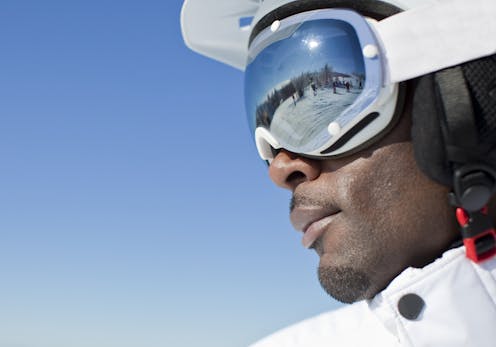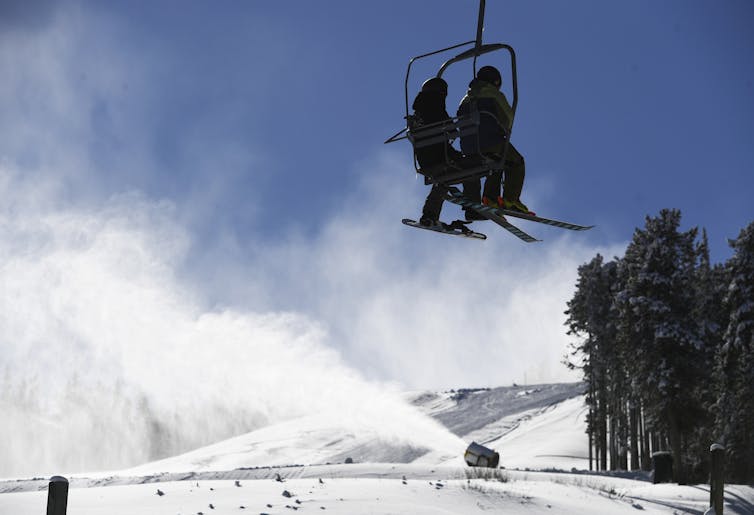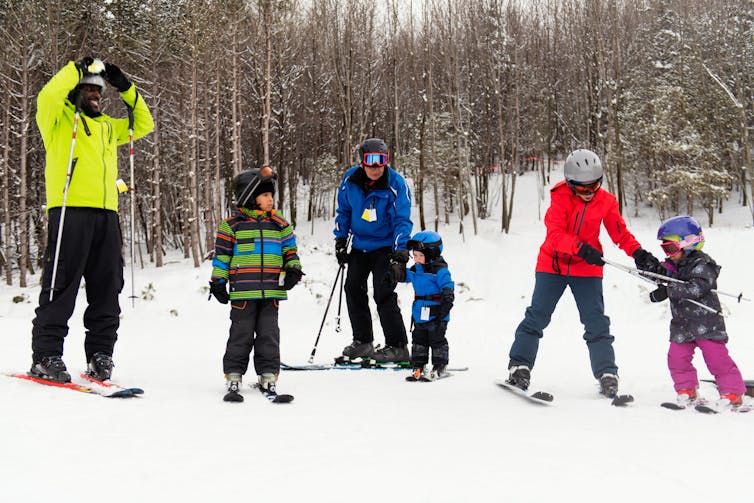Rising costs of climate change threaten to make skiing a less diverse, even more exclusive sport
As temperatures warm, ski and snowboard resorts are investing more in snowmaking and seeing their seasons shrink. Those costs roll down to customers in an already expensive sport.

Watching skiers compete almost entirely on artificially made snow at the 2022 Winter Olympics, we found it hard not to think about climate change and what it will mean for the future of the winter sports industry – and who will be able to participate.
Ski areas are increasingly reliant on extensive snowmaking operations to keep their slopes open as the planet warms. A few degrees of warming can mean more days of rain instead of snow and shorter seasons. That reduces the operators’ revenue and raises their costs.
Those costs, passed along to visitors in higher lift ticket and resort prices, directly affect who can afford to spend a day on the slopes skiing or snowboarding.
As resorts’ costs rise, these already expensive sports risk becoming more exclusive and less diverse.
Our research involves what’s known as intersectional sustainability in sports – looking at how to ensure they are both inclusive and environmentally sustainable. For ski resorts, intersectional sustainability means acknowledging that climate change may result in the unintended consequence of further entrenching the sports’ lack of diversity, and proactively seeking to prevent that.
Adaptation is necessary, and expensive
Creating artificial snow to adapt to climate change doesn’t come cheap.
Holiday Valley, a small resort in Ellicottville, New York, has invested over $13 million in snowmaking equipment in the past 40 years. On top of that are the costs of energy, labor and piping in thousands of gallons of water a minute to run snowmaking machines. Even as snowmaking machines become more efficient, the overall cost is still significant.

An analysis of the outlook for Blue Mountain, a ski resort in Ontario, Canada, offers a glimpse of the future.
In a best-case scenario, if the world achieves the Paris climate agreement goal of limiting warming to under 2 degrees Celsius (3.6 F), Blue Mountain’s ski season is to likely shorten by 8% and its snowmaking efforts would have to almost double by 2050. The window of ideal weather for snowmaking would also reduce by 22%, meaning the resort would be making snow under less efficient conditions, which further drives up the cost. Those extra costs likely will show up in higher lift ticket and resort prices.
Smaller resorts may be forced to take on debt to finance snowmaking equipment. High leverage ratios have been shown to reduce profitability for ski resorts. Some smaller ski areas have shut down, leaving fewer nearby options for skiing and snowboarding in some areas and reducing competition that could help keep prices in check.
Resorts already struggle with diversity
Alpine skiing and snowboarding resorts already draw criticism for their lack of diversity.
In 2019-20, 69% of visitors who described themselves as skiers and 61% as snowboarders identified as Caucasian or white, according to Snowsports Industries of America. The organization found the most frequent participants are even less diverse.
A separate survey by the National Ski Area Association found a wider difference: 87.5% of U.S. visits that season were individuals identifying as Caucasian or white, and only 1.5% were people identifying as Black or African American.
The Snowsports Industries of America survey also found a wealth gap. More than 63% of skiers and 55% of snowboarders had an income over $75,000, almost double the median earnings of Americans.

Some resort corporations, including Aspen Snowmass and Powdr, have committed to increasing diversity and inclusion at their resorts. Powdr, for example, has community initiatives in its “Play Forever” campaign that include awarding scholarships to help people attend their camps and a partnership with STOKED, a nonprofit that mentors young people from underserved communities who are interested in board sports.
But among several other corporate-owned ski resorts, there is a noticeable lack of diversity efforts on their corporate websites. Eight resort companies included either no mention of diversity and inclusion or provided no evidence of initiatives supporting these efforts on their corporate websites.
The results suggest to us that the rising costs of climate adaptation will leave many would-be skiers and snowboarders unable to enjoy the sports.
Three tactics to improve diversity for the future
As the climate changes, management practices can also change to keep the slopes accessible.
One effective strategy is engaging and partnering with community organizations that focus on diversity and inclusion. By working with organizations engaged in the community, Powdr can connect with disadvantaged youth and introduce them to snowboarding and skiing, for example.
[Over 150,000 readers rely on The Conversation’s newsletters to understand the world. Sign up today.]
Ski resorts can also engage directly with nonprofits like the National Brotherhood of Skiers, whose mission is to develop and support athletes of color in winter sports, and communities that are underrepresented on the mountain to understand how decisions related to climate adaptation may have the unintended consequence of further entrenching inequalities.
Resort corporations can also improve their connections with diverse communities by increasing the diversity of leadership and creating senior leadership positions in charge of diversity, equity and inclusion initiatives.
By including diverse communities in the climate adaptation discussion, ski resorts have a better chance of achieving a future where snow sports are more accessible for everyone.
Brian P. McCullough is also the Co-Director of the Sport Ecology Group.
Lance Warwick does not work for, consult, own shares in or receive funding from any company or organization that would benefit from this article, and has disclosed no relevant affiliations beyond their academic appointment.
Read These Next
What’s at stake in Trump’s executive order aiming to curb state-level AI regulation
In the absence of comprehensive federal AI regulation, states have stepped in. The Trump administration,…
Data centers need electricity fast, but utilities need years to build power plants – who should pay?
How many data centers will be built – and how much electricity they’ll need – is uncertain. Being…
Whether Netflix or Paramount buys Warner Bros., entertainment oligopolies are back – bigger and mor
Hollywood has seen this movie before.





